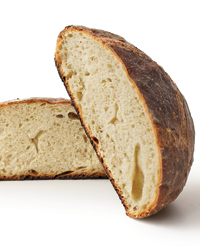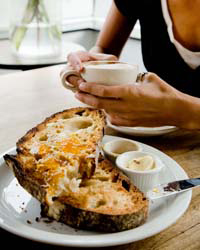 Tartine Bakery's bread genius Chad Robertson explains how bread is made and what makes a perfect loaf. Photo courtesy of Chad Robertson.
Tartine Bakery's bread genius Chad Robertson explains how bread is made and what makes a perfect loaf. Photo courtesy of Chad Robertson. A West Texas native, Chad Robertson first chose to pursue the craft of baking in 1990 as student at the Culinary Institute of America, when he was an apprentice to the renowned Richard Bourdon at Berkshire Mountain Bakery. When he was only 23, after working in bakeries in Provence and Savoie, France, he and wife Elisabeth Prueitt opened a small bakery in Point Reyes, California, where he spent the next six years “in a sort of solitary baking trance,” as he wrote in his book Tartine Bread. Using nothing but flour, water, French sea salt and wild yeasts, he made hundreds of loaves a day in a wood-fired oven, all by himself, all by hand (with help from one very gentle diving-arm mixer.) In 2002, he and Elisabeth brought their breads and pastries to San Francisco, when they opened Tartine. A gifted writer and photographer as well as baker, next year Robertson will release a book on breads and pastries made with ancient grains like kamut and spelt. Here, waxes lyrical on the ideal loaf.
When I was still in culinary school, we went on a field trip to visit Richard Bourdon. On the drive there, Liz remembers me saying, “Hmm, I wonder if I’m going to want to become a bread baker and start working with him.” That’s crazy, because I was just a little kid, and it’s not like I had been there before. But that’s exactly what happened. There were three bakers, but a lot of the time you were working alone—one person was on the oven, and two people shaping—in a huge brick barn. And the smells: Any fresh, baking bread smells good, but walking into a huge bakery that only makes naturally leavened bread was completely new to me. It had the smell of caramelized crust that all bread has, but on top of that there was a sweet, almost yogurty smell from the lactic fermentation, definitely not sour but a little funky in a good way. Another thing about Richard: at the time maybe 60 percent of his baking was whole grain, and all stone-milled. With the whole grains and long rising time, there was a depth of aromas and flavors. It wasn’t a lot by industrial baking standards, but for a small shop they made like 3,000 loaves a day.
Making bread is not just blending together flour, water and salt, and letting it ferment a little before baking it off. It should go through this transformation where its textures and flavors become much more than an embodiment of its parts. The mixing, fermenting and baking, all of those things should work in balance so you end up with something that transcends the simplicity of its ingredients.
Everyone has a different theory about this. Some people call leavens starters and vice versa. But technically there are three stages to harvesting wild yeasts to make a naturally leavened bread. In the first stage you make a pretty sour starter that has a lot of acid by mixing flour and water and letting it ferment. Then the next two stages you feed the starter with more water and flour to cut that acid down and promote the growth of wild yeasts. Then you add the final stage to the dough. You need some of that acid to give wet doughs the strength they need—acid conditions the gluten. Acid also provides a sour flavor, which is important to get the right balance for the taste. But to promote the wild yeast you want a less acidic environment. Some people also think wild yeasts prefer certain temperatures. I keep everything at a pretty warm temperature—the starters and the ingredients I feed them—since my experience is that it best promotes the wild yeasts. But as for what they’re called, some call the first stage a starter, and the second two stages leavens. Some call the first two stages starters and the last one a leaven. Some call all three stages starters, and some call all three stages leavens. Technically, I think the leaven, or levain in French, is the last stage that goes into the final dough.
A pan loaf is baked in a pan; a hearth loaf is baked directly on the floor of the oven, or on ta stone. Pan loaves tend to have less crispy crusts than hearth loaves, but not always.
Once you add flour to water, proteins in the wheat will start to form gluten strands almost immediately. A good bread should have tender, extensible glutens. If you don’t mix dough gently, you can overwork, overtighten and even start to break down the gluten before you’ve even started the dough rising. The whole web of gluten that you’re trying to develop will already peak and try to degrade. So you’ll get smaller, tighter and—worst-case scenario—flat breads that are really dense.
More and more people are using longer rising or fermenting times now. People see how important it is, and how their customers appreciate it. A longer rise definitely improves flavor. It also helps break down the grains to make the bread more digestible. And it tenderizes the gluten, though if you over-ferment the gluten can become so tender that the bread comes out flat. But the longer you ferment, the more sugars are more available to caramelize during the baking. The loaves brown faster and the crust gets darker.
High hydration, or a dough with a high proportion of water to flour, is very important for a lot of reasons. Texturally, a moist dough will have more volume. It will also ferment at a lower rate to take on more layered flavors, although it can go overboard and a too-wet dough can ferment too fast. But generally the combination of more water and baking to a higher internal temperature will also gelatinize the starch more thoroughly, and gelatinized starch forms an important part of the texture of the crumb.
I don’t know why anyone ever pushed bread dough out on a table; it doesn’t make sense to me at all. It’s a big mess for one thing. Then you’re not able to insulate the temperature of the dough, which you want to keep at a constant. If you’re doing it on stone or marble it will chill the dough down, which you definitely don’t want. And you’re trying to turn the flour into gluten before it’s ready, before it can absorb any water. Maybe it comes from making pasta. But bakers were using troughs at the turn of the century; it’s so obviously a better system. Kneading promotes the formation of glutens, or long strands of proteins that give the dough structure and trap air bubbles as the yeasts digest. While the dough sits in a bowl or trough, the gluten starts to form on its own and hydrate, to swell and relax without you having to do anything. It prepares itself for you to start stretching the strands, which is what makes a nice loaf of bread in the first place. Where the other way, you’re trying to pummel it into something when it’s not ready. I’ve always been taught to work with the nature of the dough, and that kind of gentle coaxing feels more true to its nature.
In the heat of the oven the loaf wants to expand; that expansion is also known as oven spring. If you don’t cut the dough, the loaf will stay smaller but still have a blowout somewhere on its side. If you cut it, it can expand to its full volume. So the slash is a decorative way to control how it expands. It can also double as a baker’s signature or brand. And it’s an important part of the bread’s flavor expression. When the baker scores the loaf, these ears curl up along the edges. Those thinner pieces of dough get dark and crusty, and provide a kind of accent of burnt flavor. It’s small related to the rest of the loaf, so it’s not overpowering.
Steam does a few things: It moistens the baking environment so that the loaf can expand during the oven spring. And it also moistens that outer layer of starch in the dough, to start proper caramelization. Without steam that caramelization can’t really happen. You’ll get a small loaf that looks muddy and chalky on the outside because it can’t caramelize. At home you can get much of the same effect by baking bread in a preheated cast-iron pan with a lid.
Crust: I don’t like pale breads, because you miss out on all the flavors of a caramelized crust. I also like a strong contrast between a crisp crust and a tender crumb. When I see a bread that doesn’t have an interesting crust, I’m not all that compelled to taste it. Ideally, I like see a range of colors—some dark parts, some golden, some light. If the crust was all dark, it would all taste toasty and burnt and be too overpowering. But if there’s a little of this and that, it’s in balance. It’s like a steak on the grill: You want some black bits, but you don’t want it to be charred all over. And if it’s pale, it’s going to be totally bland.
Big bubbles: Big bubbles in the crumb are a sign of all the other qualities: You can’t get an open texture if you overwork the dough, if the starter’s too sour, if you haven’t cut the loaves properly, if you don’t steam the oven. When I see a loaf with big holes, I can already tell it was made well without tasting it.
A glossy interior: When you cut into a loaf and it looks super-glistening, super wet and shiny, some people will think it’s underbaked—people have said this about my bread. But if you press it, it will be moist or wet to the touch, but it bounces back because the starch is hydrated and gelatinized. It’s fully cooked, it’s just wetter than people are used to.
A mildly sour taste: This is just my personal preference, but I prefer breads that aren’t too sour. I love the flavor of some acid, but I tend to agree with the traditional French view that bread is a daily part of the meal, meant to go with whatever you’re eating. You don’t want the bread to be so acidic that it’s clashing with the food. You also don’t want the acid to overwhelm the more subtle grain flavors in the bread. I can tell when my leaven is at just the right stage: The whole baking room has no vinegar smell at all, just this sweet lactic smell. That’s when I know the final bread will be exactly what I want.
The flavor of the grain: More and more I’m finding that the quality of the grain and the freshness of the milling are huge factors. I’ve eaten a lot of loaves that look beautiful, and have all the ideal characteristics of an ideal loaf, and have very little flavor. Different wheats all taste a little bit different—kamut’s very sweet, spelt’s a little nutty, red wheat has a bitterness that can be nice. It’s nice to be able to taste those qualities in the bread.

Here, Robertson reveals essential tips and techniques for bread lovers from how to revive an old loaf to where to buy an exceptional knife that will razor through a sturdy crust. READ MORE »

Robertson shares his ultimate bakery bucket list from his Peruvian cohort to a spectacular Stockholm destination where the cardamom buns are incredible. READ MORE »

No comments:
Post a Comment